"Wait...You're leaving, too?"
I still remember how surprised my coworker and I were to discover that we were both leaving the company within days of each other. And without ever having talked about it.
Years later, I've met many friends who have been on both sides of employee turnover waves. I've learned they're always challenging for teams, their leaders, and the company as a whole – and costly.
The high cost of employee turnover
Losing a single employee can cost tens of thousands of dollars. If you're replacing an engineer, that can cost you more than $100,000 for a single employee. And a wave of employee turnover can quickly run up costs ranging into the hundreds of thousands– or more. Talk about a big hit.
Even just finding a replacement adds up fast. According to a study published by the Society for Human Resource Management, when an employee leaves, it costs an average of 6-9 months of your former employee's salary to identify and onboard their replacement.
Can you afford that kind of employee turnover hit financially or to productivity? Doubtful.
Yet, it often happens to leaders, causing employee turnover rates for some companies to spike as high as 30-40% annually.
To understand how to stop a wave of departures from happening, you first need to understand why waves happen in the first place.
Table of Contents:
- Why Your Employees Leave in Waves
- How to Spot the Signs of a Resignation Wave
- How to Stop an Employee Turnover Wave
- How improving your onboarding process can prevent your employees from quitting later
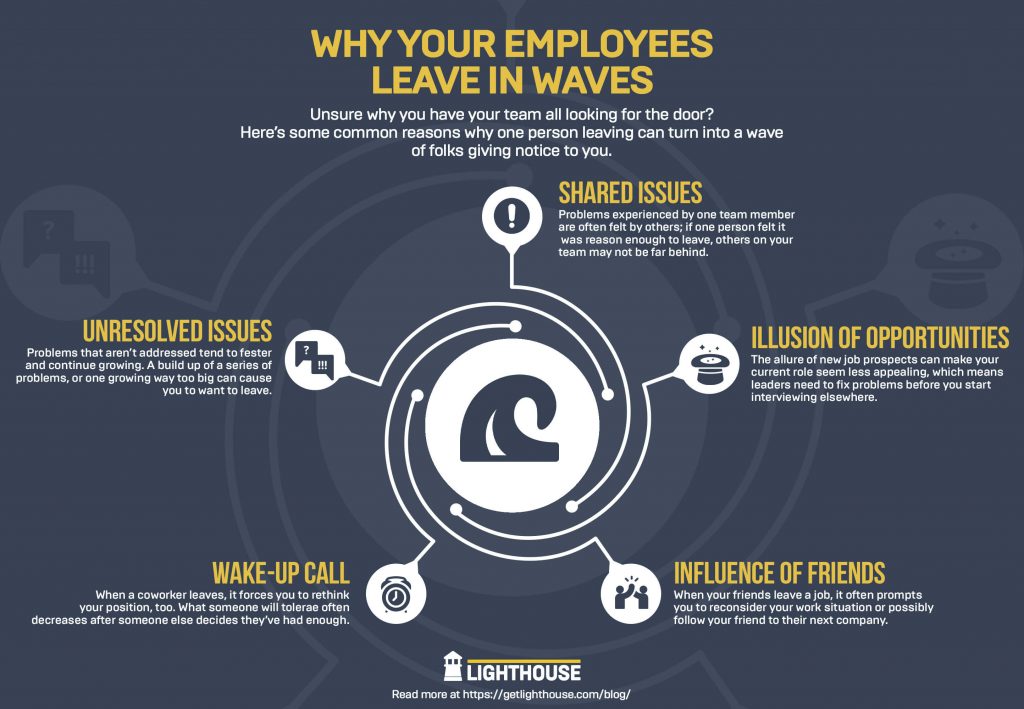
Why Your Employees Leave in Waves
While every team and company is unique in some ways, there are a few patterns that hold true across all companies. In our time helping leaders over the last 6 years, and looking at the latest research, we've found a few of those patterns:
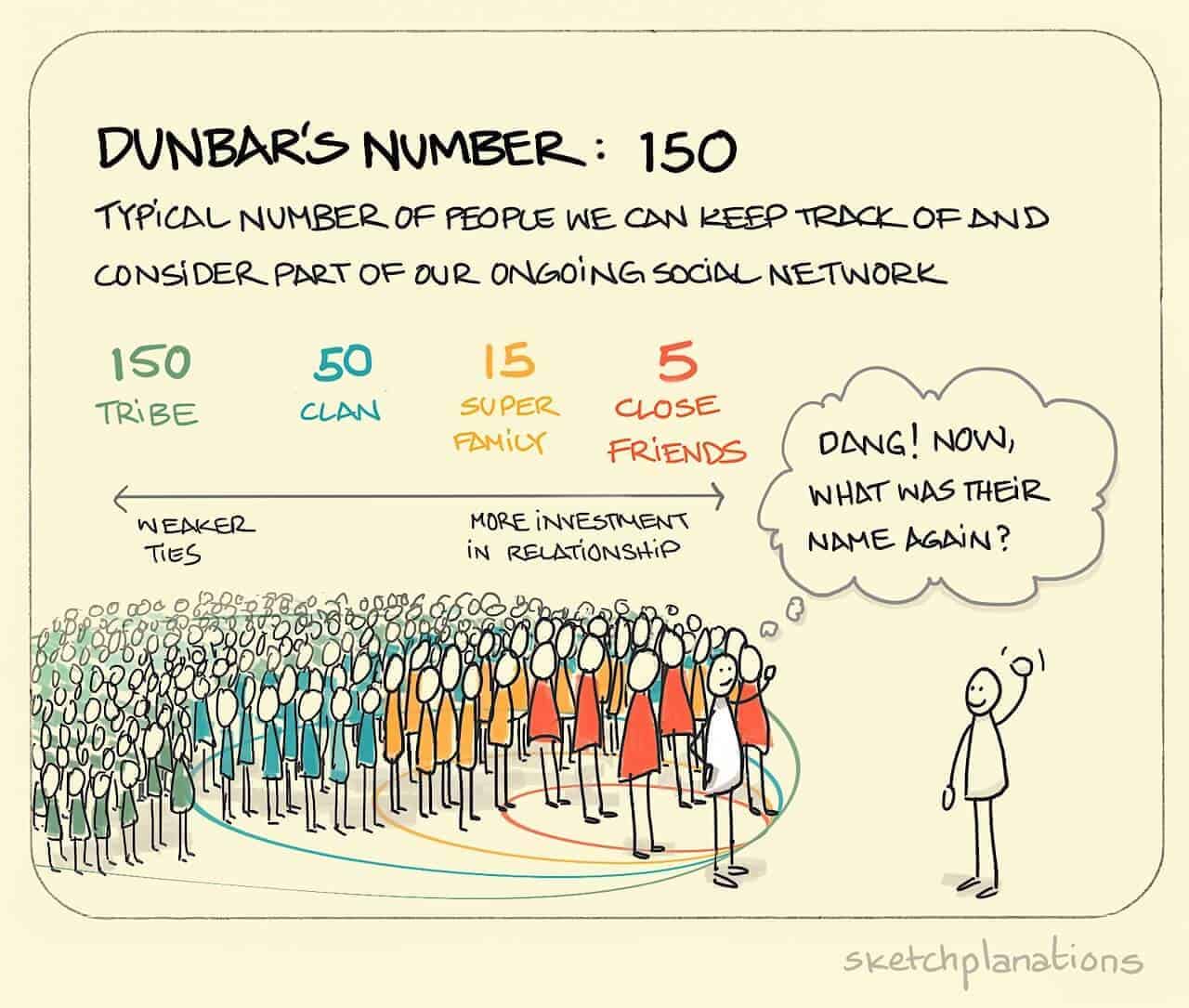
1) We're social creatures.
Researcher Robin Dunbar (famous for Dunbar's number) theorizes that the main reason humans have such large brains is to manage complex social relationships in a community.
Work is one such community, complete with politics, drama, alliances, and social norms. As social creatures, we talk about the good, the bad, and each other.
If one person on your team perceives a problem, chances are others feel it and have talked about it, too. Whatever is bugging one person is usually bugging others; they just haven't told anyone yet (or you missed the signs). Over time, issues build on one another enough to lead to people considering leaving.
For example, a friend of mine runs a 10-person startup. Each month he surveys his team on a variety of questions about how he's doing, things going on in the company, and so on. When he reads the anonymous answers, he will often take that feedback and ask his team about it.
To his continued surprise, most everyone on the team has thoughts on the feedback. And whoever wrote the feedback isn't the person he thought. When he addresses the issue, he knows he's fixing something that everyone will appreciate.
Takeaway: Whatever issue(s) caused someone to want to look for another job is probably being experienced by others on your team as well.
2) The grass is always greener...
When you're being recruited, a company highlights all the awesome things about the job and the company. They also do their best to hide any less-than-desirable aspects.
You've probably done this yourself when recruiting. After all, we all want to put our best foot forward.
Unfortunately, when you're frustrated at your current job, this gives any new job you're scouting more appealing than it actually is. Most companies are dysfunctional in their own unique ways, so what was wrong at one job will not be a problem at the next.
However, every company has issues. Issues you'll only learn about weeks or months after you join.
Anyone on your team that is interviewing for other jobs is hearing the greener grass pitch. Compounding things, a person leaving the company will likely talk excitedly about their new job to their friends. Adding to the potential of employee turnover.
Even if you keep them from giving a 2-week notice, they'll still likely be in touch with colleagues who will hear how great the new place is over drinks, email, or social.
Takeaway: Once people are looking, they'll be enchanted by the attractive pitches they're receiving and word will spread to their coworkers.

3) Friends are a double-edged sword.
It's great when people recruit a friend to your company or team. It saves you a lot of money and time sifting through foreign resumes and questioning if they're a culture fit.
I've seen many companies hire whole groups of people who have worked together for years and are friends both personally and professionally. It can be a huge win as they already know how to work well together and have great team chemistry.
But therein lies the double-edged sword: when one of them leaves your company, their friends will likely follow.
I was recently getting brunch with a friend. We'll call him Jeff. Jeff left the company I first met him at to join a startup along with his good friend.
Unfortunately, Jeff's friend got into a major, ongoing argument with his manager and left the company over it. Jeff lamented to me how much he missed working with his friend and seemed to be considering leaving.
A few weeks later, by random chance, I was walking down the street and someone from the startup Jeff was at struck up a conversation with me. When I mentioned I knew Jeff worked there, I found out he had actually just left. The double-edged sword struck again.
Takeaway: If people recruit their friends to your company, they're also likely to draw them away and cause employee turnover when they leave.

4) Their departure is a wake-up call.
Even if an employee isn't close friends with the person leaving, it can be a wake-up call to them and everyone else in the company.
They may ask themselves, "If they're leaving, maybe I should too,” or, "If he got that kind of offer, I wonder what I could get?” This means that even people that weren't at risk can become a risk just out of curiosity or the fear that, "the rats are leaving a sinking ship."
It's easy for employees to get set in their ways and put up with a tough situation. They can be comfortable at your company for any number of reasons and finally seeing someone do something dramatic (like interviewing somewhere else or leaving) can make them re-evaluate what they're doing.
Depending on how the person's departure is handled, it can also generate strong feelings. The true colors of a company's leadership can show in these situations. If everyone that leaves is wished well and thanked for their efforts, people will have a very different opinion than if they're booted out the door and criticized behind their backs.
Takeaway: When someone leaves for another job, it makes everyone else on the team re-evaluate their situation and consider at least looking around - opening the floodgates of employee turnover. For some, that can mean simply opening one of 20 recruiter emails they get every day.

5) Momentum takes time to build and time to stop.
Most people don't quit their jobs on a whim. It takes a lot to decide to interview elsewhere and even more to accept an offer. It can be scary to pretend you have a dentist appointment to take an interview and pretend there are no problems if someone asks you in the office.
And if things are bad enough for one employee to consider leaving, it's likely that those issues are affecting others on the team.
You have to diffuse the problem and convince people things will and are getting better. Unfortunately, that doesn't happen overnight.
Problems build up over time. They grow and spread the longer they linger. Fixing problems is one of the hardest things for a manager to deal with. A big enough issue can consume much of your time and prevent you from getting in front of other small problems, among other things.
Your one ally in this is progress: if you can start showing progress on the critical issues, you can convince your team that things are going to get better.
Takeaway: Whatever problems have built up to cause people to consider leaving will take time to improve. And, until there's improvement, it will be a source of motivation for employees to leave their manager. Be sure to pay down any management debt you build up before it costs you.
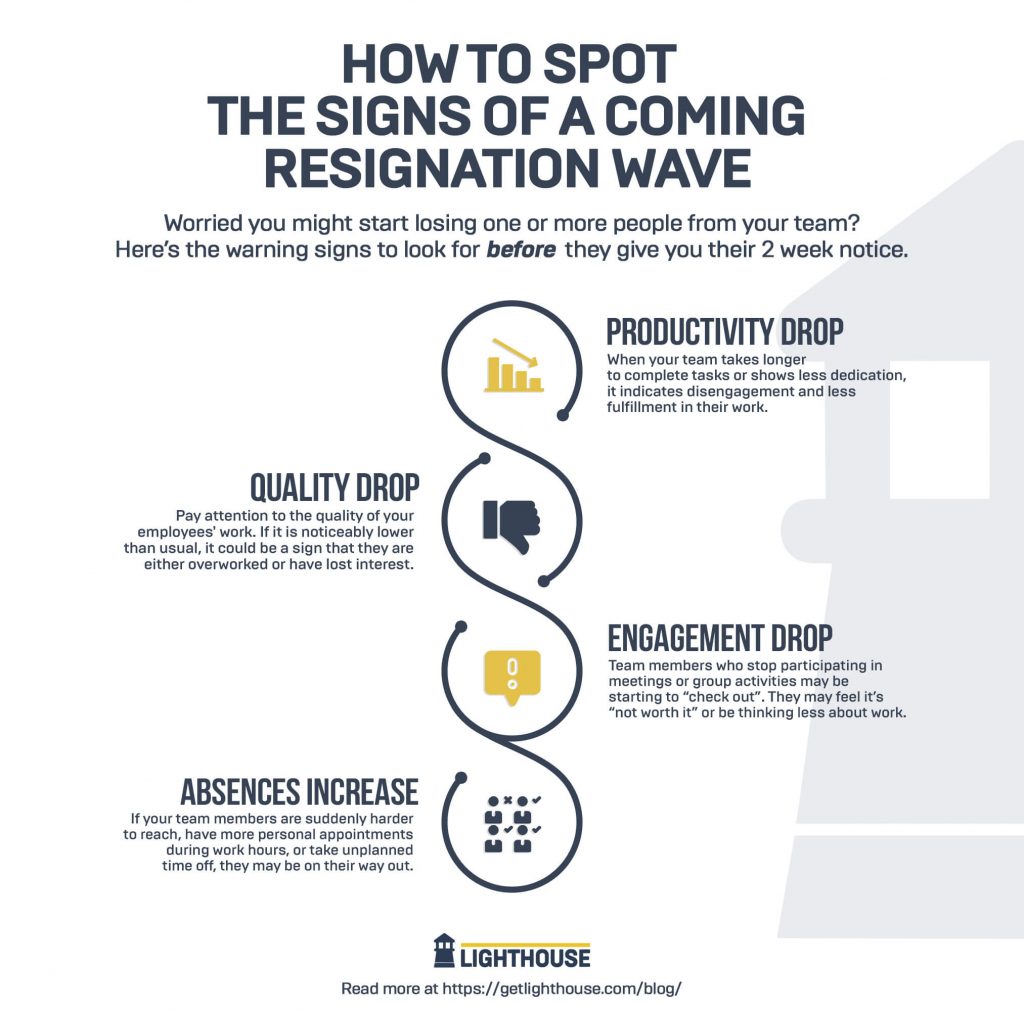
Employees Leaving in Waves: How to Spot the Signs
It’s important to know how to recognize the signs of an incoming resignation, in order to be able to address possible issues early on and fix them. If you’re worried someone on your team (or multiple people) may be considering quitting, look for these signs in your employees’ behavior:
- Their productivity drops. If an employee suddenly takes more time than usual to complete the tasks on their regular to-do list, or become less dedicated to dealing with the challenges of their job, this could mean they are starting to disengage from their work and are probably not finding it as fulfilling as before.
- Their work quality drops. Are some of your coworkers turning in work that is noticeably below their usual standard? They might be struggling with their workload or task maturity – or they just might be phoning it in. An increase of task delegation, or a drop in attention to detail, are strong signs an employee is not enjoying their job anymore.
- They don’t participate and engage like they used to. Previously outspoken and extroverted employees suddenly stopping participating in meetings, or frequently excusing themselves from group activities, are strong signals that they are no longer as excited to work at your company and on your team as before.
- They have a lot of unexpected absences. Employees who become harder to reach if working remotely, start scheduling more personal appointments during work hours, or suddenly take a lot of unplanned time off, might be networking or even interviewing for other jobs. Unfortunately, this sign is the riskiest to wait for as they could already be very close to another offer.
All of these signs, separately, might indicate that someone is going through personal challenges and work is coming second. However, if an employee is exhibiting all of the mentioned behavior at the same time, it’s likely they are actively searching for a new job.
Recognizing these signs and knowing when it’s time to talk with your employee one-on-one to understand how they’re doing, could make all the difference.
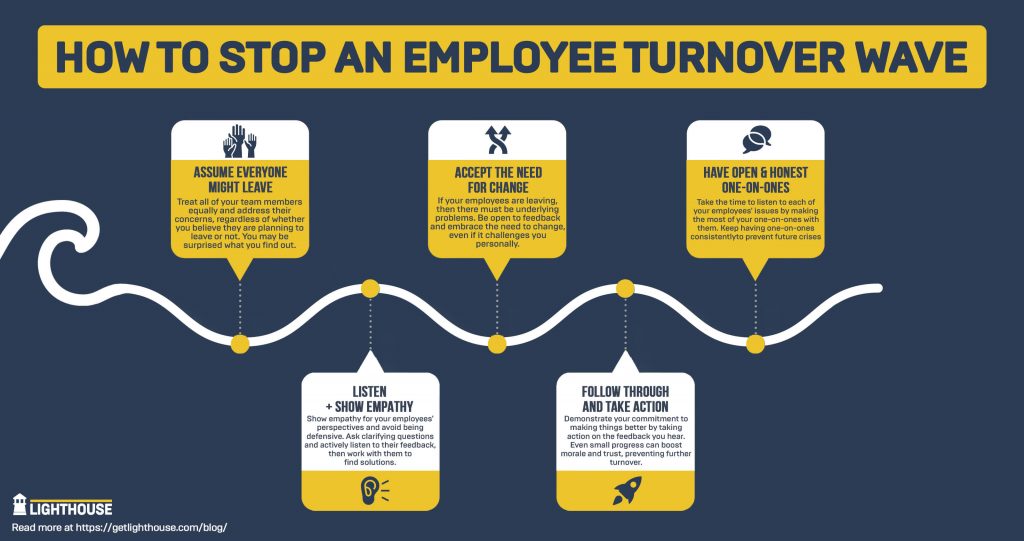
How to Stop an Employee Turnover Wave
Once your employees are leaving, the deck is stacked against you, but it's possible to turn the tide. It just takes some hard work and the willingness to focus on your people.
As Jason Lemkin writes, "Once they tell you they have another offer … they're already out the door.” But that doesn't mean you can't save the people still on your team, even if you think they might be interviewing.
Here's how you can turn the tide and stop a loss of one or two people from ballooning to much more.

1) Assume everyone is leaving and interviewing.
You should talk to everyone on your team, regardless of whether you believe they're planning on leaving or not.
Don't set the standard that the only way to get attention is if you fear they're interviewing. Everyone on your team deserves the same treatment. After all, they could be next.
Realize as well that even those that stick around may only be doing it out of necessity. It could be due to a:
- Visa or immigration restriction
- Big life event approaching–wedding, baby, buying a house, etc
- Or waiting on a promotion before leaving so they can get a better title and salary elsewhere.
These employees deserve the same attention and opportunity to help make circumstances better for themselves and their team.
There's also a good chance that the rest of the team is not as productive and motivated as they could be during this time. Just because you're staying doesn't mean you're happy.
Therefore, if you fix your work environment's issues, everyone will likely be more engaged and productive in addition to improving your employee turnover rate.
Takeaway: Don't take anyone for granted. Assume that everyone is considering leaving and invest in listening to, and improving things for, everyone on your team.

2) Accept that what you're doing now isn't working.
Just because you're happy or satisfied doesn't mean everyone else is.
If your employees are leaving, it's a huge signal fire that there are problems to be dealt with. Be open to their feedback and the issues they bring up (especially if they're about things you do).
It may be difficult to hear, and the solutions may be difficult to implement, but realize that the situation is dire. Ultimately, it's change, or lose them.
You need to accept this before you start talking to your employees. Otherwise, you'll likely find yourself being defensive of anything you hear and find it hard to bring about any of the changes you need to. Besides defensiveness won't positively affect getting team feedback from employees.
Only once you accept change must happen can you be ready to turn the tide on a wave of employee departures.
Takeaway: When multiple team members are leaving, it's a sign that change is needed. Accept that this change must start with you and embrace that mindset. It might be your fault for causing low employee morale.

3) Have open, honest, lengthy one-on-ones.
There's usually more than one reason why your employees are considering leaving. These problems have likely grown to cause the wave you have now.
You need to prioritize taking the time to listen to your unhappy team and take them seriously. This may slow down some work, but it beats the lost productivity when you don't have a team member on staff anymore at all.
To help you organize your 1:1s and have everything you need in one place, we've prepared a free meeting template you can download below:
These meetings should simply be called one-on-ones, not "rescue meetings,” "stay interviews," or "retention efforts”. You don't want to imply that the only reason you're doing them is because of the threat of people leaving.
And you should keep doing one-on-ones long after this turnover wave is a distant memory to ensure you never return to this kind of crisis (don't settle for quarterly check-ins).
While you may be really busy, an investment in regular one-on-ones will pay you back many times over.
Takeaway: Start having one-on-ones with everyone on the team weekly (or biweekly for large teams) and keep having them so problems never overflow again.

4) Listen & show empathy.
According to Rachel Green, Director at The Emotional Intelligence Institute in Western Australia, defensiveness holds many leaders back. Defensive leaders have a hard time admitting they need to make improvements, which makes the build-up of issues inevitable.
Resist the temptation to be defensive. The only way obtaining, and acting on, feedback from regular one on ones with your team works is if you respect their opinions and understand that the alternative is losing them altogether.
They may not even trust you enough to really open up on the biggest problems, so do your best to empathize with their view of the world; they likely don't have access to the same information you do, nor the same perspective of what's going on in the company and on the team as you do.
As Andy Grove writes in High Output Management, managers should apply Grove's Principle of Didactic Management:
"Ask one more question!” When the supervisor thinks the subordinate has said all he wants to about a subject, he should ask another question.
He should try to keep the flow of thoughts coming by prompting the subordinate with queries until both feel satisfied that they have gotten to the bottom of a problem."
Your job in these meetings is to understand their issues and help create ways to resolve them by listening and asking questions. Then work together to make changes based on what you learn to improve their work life.
If you're looking for some ideas on the kinds of questions to ask, here's a comprehensive list of one-on-one questions to ask.
Takeaway: One-on-ones are all about them. Come with questions and an eagerness to understand their point of view, so you can fix what's causing your employee turnover.
And for more on overcoming defensiveness, read these posts on developing self-awareness to become a better manager:
- Mindfulness at Work: How Mindfulness Can Make You a Better Manager
- Leadership Lessons: How to Overcome Your Personal Weaknesses

5) Follow through & take action.
The best way to build trust with employees that might leave is to take action on the feedback they give you. You may not be able to fix all the problems, but even small, incremental progress can really improve employee morale and attitude.
Chances are, in your first meeting they won't tell you the deepest, hardest problems bothering them. Instead, you'll likely get 1 or 2 smaller things that they will use as a test as to whether they can trust you, and to see if anything will change.
If you do nothing at this point, you've lost. They'll say to themselves, "James and Tanya were right…nothing's ever going to change around here.”
If their honesty is deflected or punished in any way, you'll never get any truth from them again…until their exit interview. However, if you do start showing that progress, you can slowly win them back and get to the bottom of the problems plaguing the team.
Takeaway: Make sure you take action on everything you can from your discussions. Trust is very fragile at this stage and must be rebuilt over time by making progress on what's important to them.

A secret culprit: How improving your onboarding process can prevent your employees from quitting later
So far, we've talked about why employees leave in waves. We also talked about what to do to manage employee turnover by implementing a system for obtaining and acting on employee feedback.
However, there's something else you can do to reduce your employee turnover rate significantly long before it ever becomes a problem. That's by improving your employee onboarding process.

Set your employees up for long term success starting on day 1
According to a report by The Wynhurst Group, new employees are 58% more likely to stay at their employer three years later if they had an effective onboarding experience.
It's no surprise then why companies with effective onboarding also report greater revenue and profit margins:
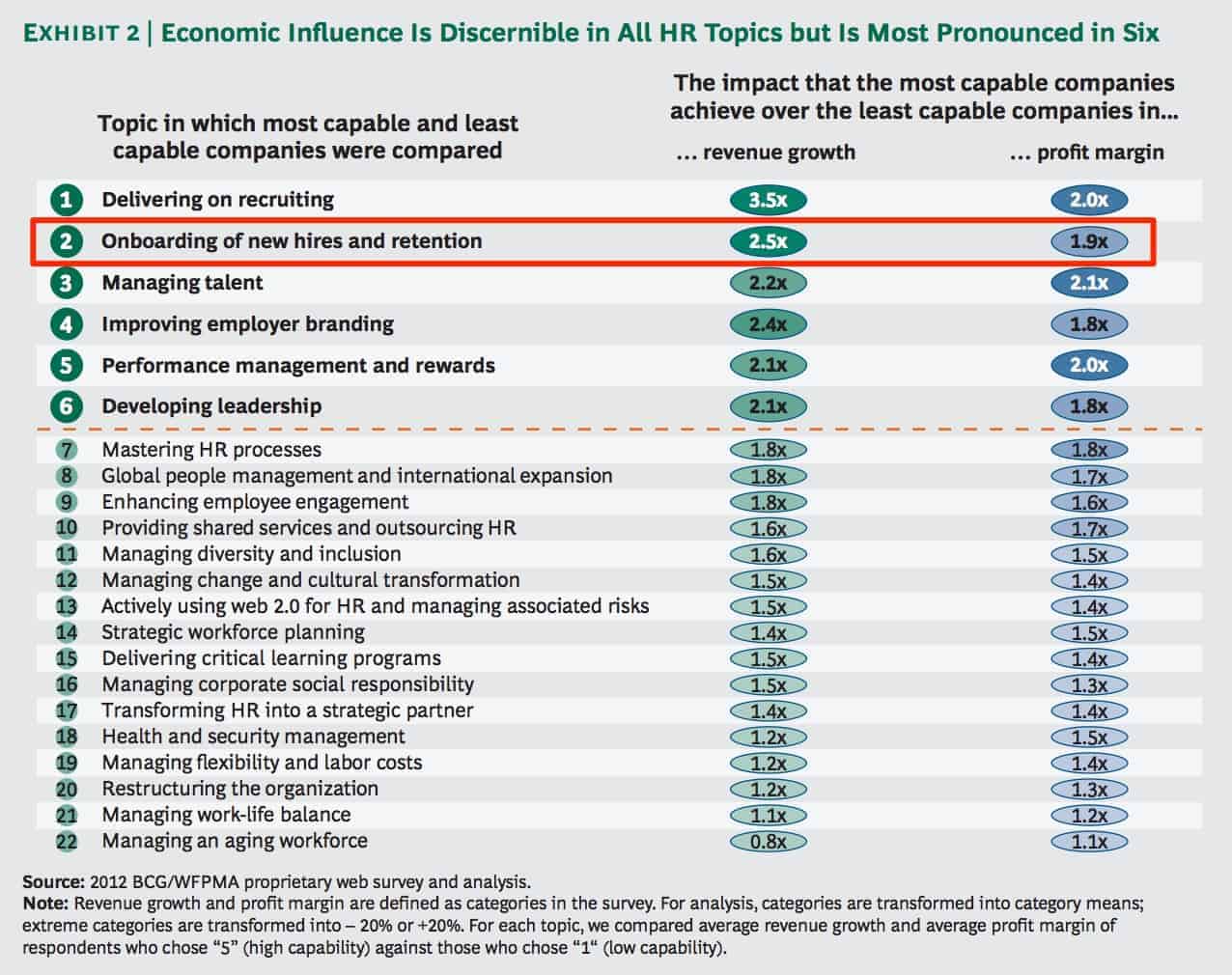
The problem is, according to a study by Gallup, just 12% of employees "strongly agree” their company does a good job onboarding new employees. Chances are, you're in the other eighty-eight percent and could use some improvement.
3 Tips for improving your employee onboarding process:
Fortunately, there's a lot you can do to improve your onboarding process to help reduce your employee turnover rate. Here are a few places to get started:
- Write out an onboarding plan: If you don't know exactly how you onboard new employees, including a written checklist everyone is familiar with, chances are your onboarding is poor. Start by writing out a list of everything that gives your new hires what they need to have a great first day, week, and month. Then, work to put those pieces in place and iterate.
- Give new employees a buddy: A buddy is a quick and easy way to improve your onboarding process. It gives your new employee someone to connect with personally right off the bat. Plus, it's an easy and satisfying role for other team members as a kind of mentor. As a bonus, the new team member knows who they can ask questions of, while saving the rest of your team from too many interruptions.
- Use welcome kits to make new employees feel welcome: A welcome kit is a great way of showing your new hire what your company is all about in a nice, neat little package. It's a great way of demonstrating your culture and making them feel, welcomed warmly. Below is one that the SalesForce UX team gives to their UX designers:

There's a lot you can do to improve your employee onboarding process (and reduce your employee turnover rate in the process). However you do it, ultimately, the point is to:
- Make them feel welcomed and accepted as a person (help them connect with other team members and feel psychological safety)
- And give them everything they need to get off to a fast start (feeling progress in their new role and getting your company productive team members faster)
To learn more about improving your company's onboarding process, read How to Improve Your Employee Onboarding Process to Engage Your Hires & Prevent Employee Turnover
Further reading:
To learn more about reducing employee turnover and maintaining a happy and productive team, read:
- What to Say to the Team When Someone Resigns
- 13 Reasons Why Great Employees Quit
- How to motivate an employee that is underperforming
- Why People Leave Managers Not Companies (And 5 Things You Can Do About It)
- How To Calculate Your Employee Retention Rate







